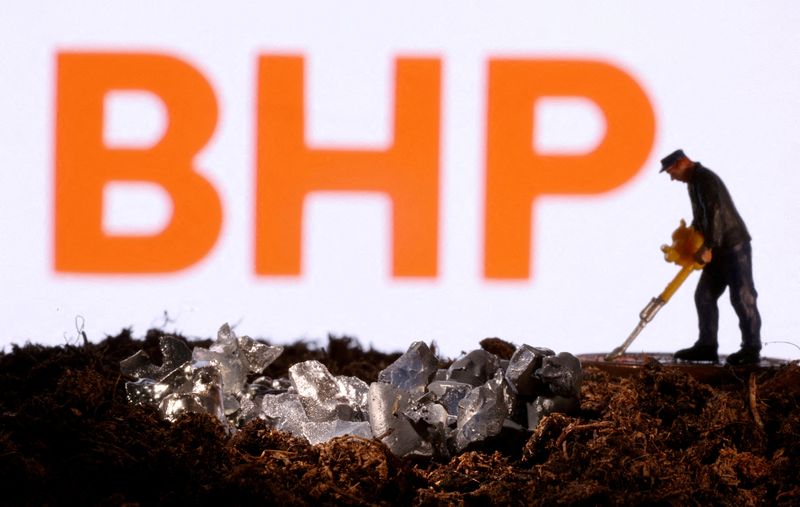BHP first half profit beats expectations, inflation impact recedes By Reuters
[ad_1]

© Reuters. A small toy figure and mineral imitation are seen in front of the BHP logo in this illustration taken November 19, 2021. REUTERS/Dado Ruvic/Illustration/File Photo/File Photo
By Sameer Manekar and Melanie Burton
(Reuters) -BHP Group on Tuesday logged first-half underlying profit that slightly beat analyst expectations, buoyed by strong iron ore prices, and said the worst of inflation impacts were receding although it remained cautious on China’s economy.
The world’s largest listed miner said it was not yet clear how effective China’s stimulus policies push has been and said it would remain cautious on its outlook. It noted, however, a “more balanced” demand picture in India, which has shown healthy momentum.
BHP said it expects a “more balanced global economy and evidence that the worst of the general inflationary wave is behind us, (to) have a positive impact on our industry in calendar year 2024.”
For the first-half, BHP’s strong revenue growth of 6% was underpinned by higher iron ore and prices and contributions from new projects, but was partially offset by lower energy coal realised prices.
BHP said underlying profit attributable to shareholders was $6.60 billion for the six months ended Dec. 31, unchanged from the previous year, but topping an LSEG estimate of $6.42 billion.
It declared an interim dividend of $0.72 per share, compared with $0.90 per share a year earlier. That beat Citi’s expectation of $0.68, and Visible Alpha’s consensus of $0.70.
“Market should take modestly higher dividend than expected as a reflection of BHP’s improving confidence regarding outlook on commodity demand/prices,” analysts at Citi wrote.
NICKEL
BHP, which announced a $2.5 billion impairment charge for its Western Australia Nickel business last week, said it sees the nickel industry facing “a difficult multi-year run.”
“Our base case is that the market may rebalance by the late 2020s.”
While it welcomed Australia’s moves to shore up the nickel sector though a production tax credit, BHP said that should not take the focus of ensuring “the right policy settings are in place to drive long term competitive positioning of Australia as a nation.”
Those settings include improved industrial relations settings, opportunities for improved fiscal settings, removing permit duplication. However, for those companies that have already put their operations into care and maintenance, that might not be enough, CEO Mike Henry said.
“Given just how significant the challenges in the nickel market are today, that may not be enough to alter course.”
($1 = $1.0000)
[ad_2]
Source link

© Reuters. A small toy figure and mineral imitation are seen in front of the BHP logo in this illustration taken November 19, 2021. REUTERS/Dado Ruvic/Illustration/File Photo/File Photo
By Sameer Manekar and Melanie Burton
(Reuters) -BHP Group on Tuesday logged first-half underlying profit that slightly beat analyst expectations, buoyed by strong iron ore prices, and said the worst of inflation impacts were receding although it remained cautious on China’s economy.
The world’s largest listed miner said it was not yet clear how effective China’s stimulus policies push has been and said it would remain cautious on its outlook. It noted, however, a “more balanced” demand picture in India, which has shown healthy momentum.
BHP said it expects a “more balanced global economy and evidence that the worst of the general inflationary wave is behind us, (to) have a positive impact on our industry in calendar year 2024.”
For the first-half, BHP’s strong revenue growth of 6% was underpinned by higher iron ore and prices and contributions from new projects, but was partially offset by lower energy coal realised prices.
BHP said underlying profit attributable to shareholders was $6.60 billion for the six months ended Dec. 31, unchanged from the previous year, but topping an LSEG estimate of $6.42 billion.
It declared an interim dividend of $0.72 per share, compared with $0.90 per share a year earlier. That beat Citi’s expectation of $0.68, and Visible Alpha’s consensus of $0.70.
“Market should take modestly higher dividend than expected as a reflection of BHP’s improving confidence regarding outlook on commodity demand/prices,” analysts at Citi wrote.
NICKEL
BHP, which announced a $2.5 billion impairment charge for its Western Australia Nickel business last week, said it sees the nickel industry facing “a difficult multi-year run.”
“Our base case is that the market may rebalance by the late 2020s.”
While it welcomed Australia’s moves to shore up the nickel sector though a production tax credit, BHP said that should not take the focus of ensuring “the right policy settings are in place to drive long term competitive positioning of Australia as a nation.”
Those settings include improved industrial relations settings, opportunities for improved fiscal settings, removing permit duplication. However, for those companies that have already put their operations into care and maintenance, that might not be enough, CEO Mike Henry said.
“Given just how significant the challenges in the nickel market are today, that may not be enough to alter course.”
($1 = $1.0000)